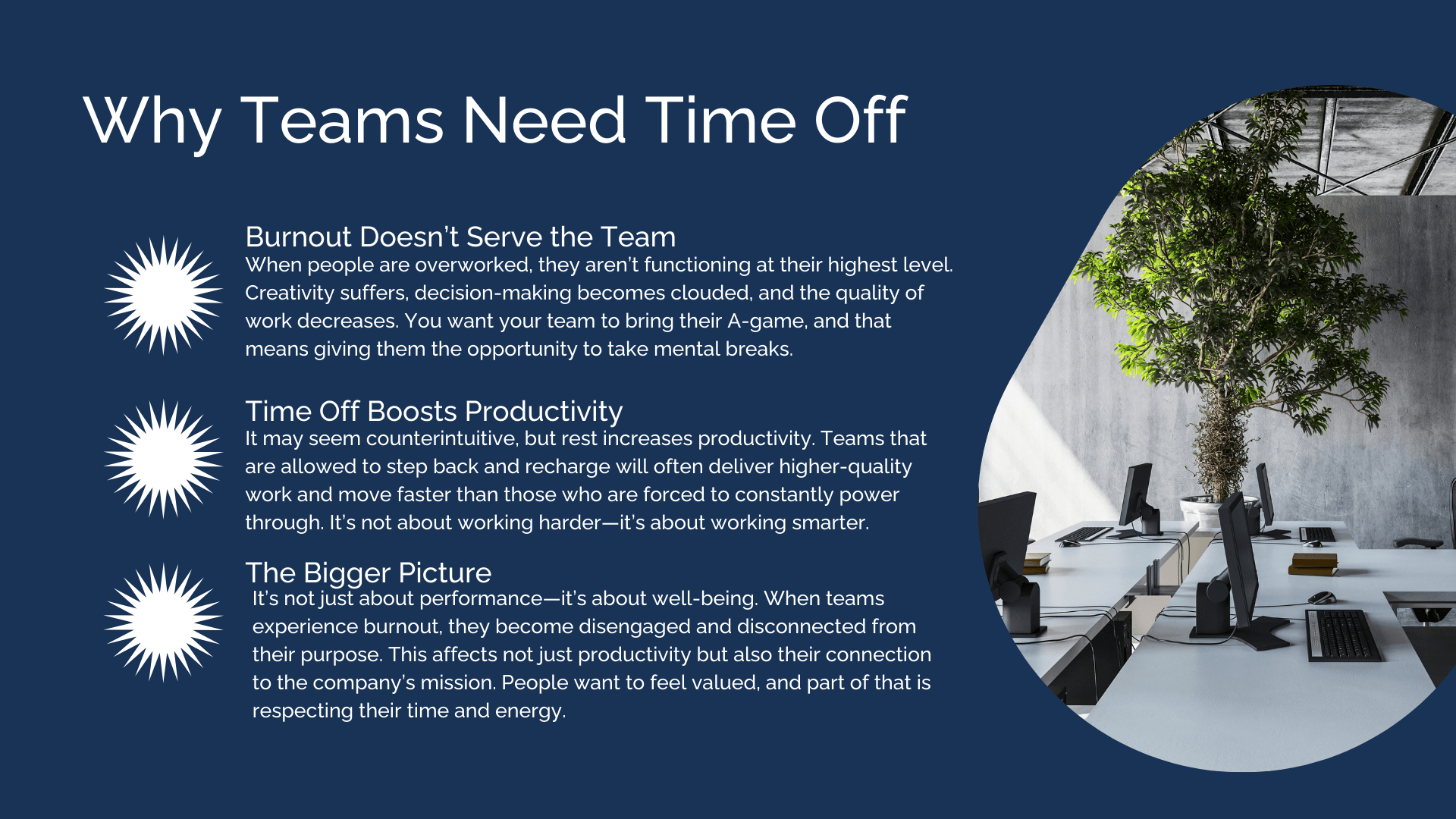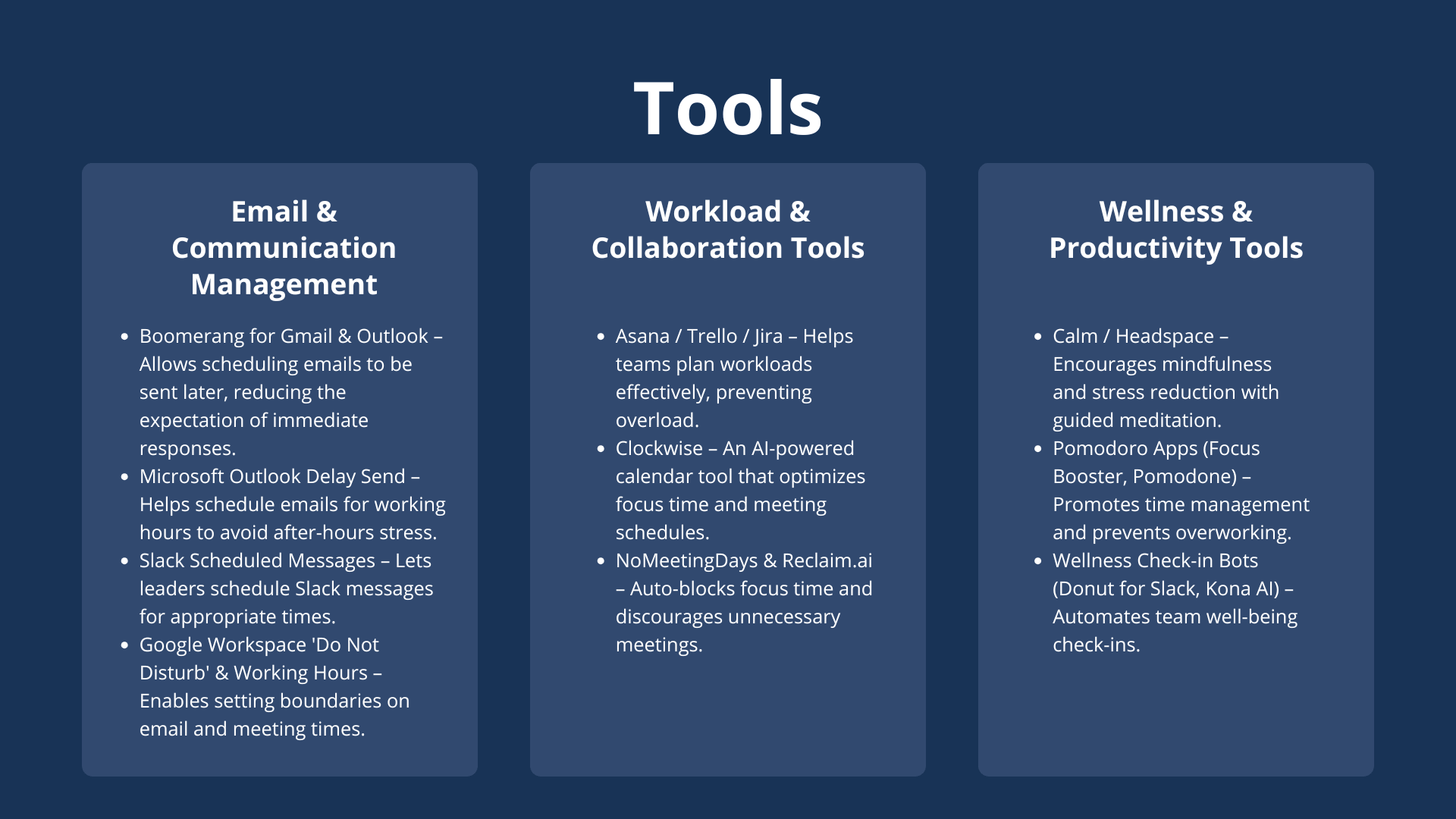
As leaders, we often find ourselves in high-stakes, high-pressure environments; depending on the organisation it might be product launches, tight deadlines, and the constant juggle between strategic goals and daily operations. It’s easy to get caught up in the whirlwind of demands, especially when the weight of your team’s success rests on your shoulders. Here's the truth: burnout isn’t a badge of honor. It’s a dangerous trap that can jeopardize not only your well-being but also your team’s performance and, ultimately, your organisation’s success.
I’ve been there. When I worked in the US, I found myself in an organization that didn’t respect boundaries. It was common for colleagues and leadership to reach out at 6 AM on a Sunday morning, expecting answers before breakfast. It wasn’t a one-time thing—it was the norm every single week. This kind of unsustainable culture highlights the poor leadership at the top, while at the same time, reflects on the poor processes established within the organisation; ones that didn't not allow for scale and automation, without any issues. This type of organisation doesn’t just hurt individuals; it harms entire teams and eventually the organizations itself. It really is extortion at it's best, in the sense, that if you don't align to this lack of boundary, your livelihood will be put on the line.
So, how do we avoid this toxic cycle of burnout and set boundaries that foster healthier, high-performing environments? Especially with organisations, or leaders that don't care?
Let’s dive in.
Why Burnout is a Leadership Issue
At the top, burnout starts and ends with the leader! When leaders normalize the hustle, overwork, and stress; when we don’t model self-care or set clear expectations, it trickles down through the organization, affecting the entire team. The team will be on tenterhooks, always looking out for emails that come through, at ridiculous hours and then snap to attention to get those replied to. It is an unrealistic expectation of leaders to have answers immediately after hours. In Australia they just laid down a law, saying that employers cannot reach out to employees after hours expecting them to do work. It is time that there was a paradigm shift, that we as leaders start to work on becoming conscious leaders, that think about the impact they have on others, to think about the opportunities to support and coach of the whole human being, that brings their inner life to work. We need to step up and move beyond transactional leadership, where we focus only on the deliverables and instead step into transformational leadership.
Often, leaders are not thinking about the downstream impacts. They might be only thinking to get something out of their heads and get their to do lists done. However, for the individuals on their teams, that is NOT how it lands, it lands as a command and to get that done now; no matter the time.
I’ve personally experienced firsthand how damaging this can be. The unwritten rules in organizations that call you at the crack of dawn, push deadlines without compassion, and expect your team to be on 24/7—these practices don’t just lead to burnout. They build resentment, discontent, and poor morale, along with high turnover and gossip culture. None of these are a good for any organisation or leader as it damages the reputation of both.
Here’s why it all begins with leadership:
You Set the Tone
As a leader, your behavior shapes the culture. If you’re constantly overworking, sending late-night emails, or pushing your team beyond reasonable limits, you’re sending a message that this is what’s expected. You create a “culture of busyness” rather than one of balanced productivity. Learn to prioritise. Prioritise your strategic goals, prioritise your initiatives that deliver on those goals, prioritise your to do list, prioritise your day. If you try to do everything, then NOTHING is a priority and you will burn out and burn out your team.
You want to be leading by example as burnout doesn’t happen in isolation; it’s contagious and you are role modelling it. When your team sees you working non-stop, they’ll do the same. You become a model for them, whether or not that’s your intention. Great leaders don’t just give orders; they live the culture they want to create by setting that example with their teams, by establishing boundaries, by focusing on established priorities and nothing else.
Long-Term Consequences
Even if your team pushes through burnout for a while, the long-term effects are devastating. Over time, stress accumulates, leading to decreased performance, lack of engagement, and eventual turnover. When a team is running on fumes, there’s no way they can bring their best work to the table. Physiologically, you are not connecting with the higher reasoning brain when stressed, so creativity and innovation are diminished greatly. If you as a leader are working 24/7, it is time to look into why. What are you running away from and avoiding, why is there no balance in your life? Where are there no priorities established? How can you better prioritise and setup boundaries? What processes are broken that cause noise every single week and need to be overhauled, to reduce the impact?
The Power of Setting Boundaries
Boundaries aren’t just about saying “no”—they’re about creating a sustainable work environment where people can give their best without sacrificing their personal lives. As a leader, it’s your responsibility to model and enforce boundaries that prioritize well-being and productivity. It's also your responsibility to establish priorities for the team and for the individuals on that team. There will always be too much to do constrained by limited capacity, regardless of the organisation. At Netflix we had a lot of money and engineers at the time Originals were growing exponentially. We all wanted to get cool innovative things done and we were also limited by the capacity of the engineers, regardless of the fact we had a lot of engineers.
🔹 Action Tip: Practice ruthless prioritisation as you will always reach a capacity limitation and you have to learn to manage within it. You need to focus your team on the things that are essential to deliver on the vision & strategic goals. That is it, everything else should be cut.
As a leader, you have to protect your time and your team’s time. I learned the hard way that working in an environment where boundaries are ignored isn’t just unhealthy; it’s counterproductive. When you constantly allow work to bleed into personal time, you burn out; not just as a leader, but also as a team. Boundaries ensure that everyone has time to recharge and return to work with fresh perspectives and renewed energy. Boundaries are also established through prioritising the work that matters. It is not realistic to expect everyone to get everything done all at once. It creates undue stress and pressure across many teams. You have to make progress towards something, chip away at the big things and give kudos when those little things are done, moving the team along towards the bigger things.
🔹 Action Tip: As a leader, schedule “off” times where you don’t check emails or take calls. Respect your team’s personal time—don’t set the expectation that they should be available outside of office hours. Use tools to manage how you work, without impacting your team. If you like doing emails at night, then by all means do them, but schedule their release for the morning, instead of that night.
As a leader you want to be setting clear expectations. Being a strong leader isn’t about having all the answers; it's about setting expectations. Set clear guidelines for when communication should occur, In fact, as a team, you can create "About Me" pages that outline who you are, what you work on, how you like to communicate, what channels you use most of the time and when the best time is to contact you. Work on communication agreements as a team that outline things such as; how urgent requests should be handled, who might be on call if needed and when people are expected to step away. Empathy is key. Understand that everyone has commitments outside of work, and these should be respected. They have families, young kids, side gigs, friends, social events.
🔹 Action Tip: Communicate the importance of work-life balance within your team. Encourage them to set boundaries and honor those limits, both for themselves and others. Establish team agreements that you all align to and create "About Me" pages that outline personal quirks
Why Teams Need breaks
As a leader, one of the most powerful things you can do is give your team the time they need to recharge. Time off isn’t just about vacations or weekends—it’s about creating space for your team to step away from the grind and come back with renewed creativity and focus. This includes managing calendars as a team, making sure that you have focus time of 3-4 hour blocks to work on things such as coding, design, discovery, research. Remember, you want to identify who is on a managers schedule versus a makers schedule. Those that are on managers schedules work in 30-60 minute blocks of time and the meeting is the work, while those on maker's schedules need long periods of time to create something. So make sure you manage calendars together and block out those focus time blocks. If you are on a manager's schedule you can book over the top of these as needed.
The Downstream Effects
When leaders fail to set boundaries and push their teams beyond their limits, the downstream effects can be catastrophic.
- Reduced Engagement and Motivation: People who are burned out don’t perform well, and they also don’t care as much about the organization’s goals. Their motivation dips, and their engagement drops. The result? Disengaged teams lead to higher turnover rates, lower job satisfaction, and ultimately, poorer outcomes.
- High Turnover and Loss of Talent: Overloading your team isn’t just a short-term problem—it leads to long-term consequences. People will leave when they’re consistently overloaded. A high-performing team needs space to breathe, or they’ll take their talent elsewhere. That talent costs you both in terms of recruitment and lost knowledge.
- Reputation Damage: As a leader, your actions reflect on the entire organization. If your team is burned out and morale is low, it can damage the company’s reputation—internally and externally. You’ll start losing talented professionals, struggling to attract top talent, and ultimately risk the organization’s success and sustainability.
Tools to help
Leaders can use a combination of email delay tools, collaboration tools, and management techniques to prevent burnout in their teams. Here are some effective tools and strategies:
How to Lead with Balance
It’s time to take control of your well-being and that of your team. Here’s how:
- Set boundaries that respect time off for both you and your team. Manage calendars together to include a makers schedule or no meeting days! Rest is needed for high performance to be achieved.
- Establish Priorities: Focus the team on things that matter and de-prioritize everything else.
- Encourage open communication—let your team know they can speak up about burnout or workload concerns.
- Model healthy work life boundaries—show your team that it’s okay to step back and take breaks and avoid sending late night emails.
- Focus on Outcomes rather than Hours: Results over time moving the dial on customer outcomes that matter
By setting healthy boundaries, you not only avoid burnout for yourself but also create an environment where your team can thrive, recharge, and bring their best work to the table.
One final note, so what if you work for an organisation or leader who just doesn't care? Well, for me, there is a value disconnect present here. The organisation or leader doesn't line up with your set of values and it is probably time for you to reflect on that and why you are wasting time in an organisation such as that. There are always options, even in tough markets right now and the question then becomes, what are you prepared to do, to work in an environment you enjoy. How long will it take for you to find that and how committed are you to doing so? Often, we just put up with the status quo and make half hearted attempts to change things, so take the time to reflect about what is important to you.
Your Turn: Have you ever experienced burnout as a leader? How do you manage the pressures of high-stakes environments while maintaining your own well-being and that of your team? Share your thoughts below!




0 Comments